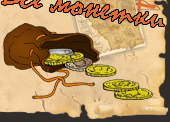
Summary
When preparing to the imminent war for reunion of the Ukraine with Russia, tzar Alexei Mikchailovitch's governement was anxious to provide for sufficient maintainance of the strelets regiments sent to the campaign abroad. For this purpose state treasury monopolized the purchase of silver, imported by foreign merchants in the form of heavy (about 29 gr/1,02 oz/) and high-standard silver coins, called talers, in Archangelsk and other frontier custom-houses. Already in XVIth century after 1520 talers were imported in a very large amount as the most convienient form of silver-article, because numerous West Europe Mints stamps upon them guaranteed the standard ("proba") and Lawful weight of silver.
By the name of Czech Jachymov (Joachimstahl), the place of the earliest mintage of talers, the latter got the name of ("yefimok"), wherever they were stroken, and were valued 50 copecks each for all XVI1 century long.
In 1654 the russian silver copecks manufacture from talers was entirely stopped; the experiments of talers restriking into russian roubles turned to be ineffective either because of technical imperfeclion, or because of absurd doubling of the declared price. In 1655 for inner currency the same copecks were stroken but made of copper, and accumulated within 6 years talers stock was turned into special russian coin for paying salary in the army with the value of 64 copecks for one taler. There were two stamps counter-marked upon them: "tzar's person" and the date "1655" (for the first time in arabic numerals and in europian chronology).
A very advantageous chance to purchase talers valued 50 copecks each at the rich fairs to the Ukraine entailed giving up further yofimoks emission and using talers without countermarks for paying salary. Thus accumulated in 1649-1655 talers (about one million pieces) almost from all Western Europe (exept France and England, which did not permit export of their coins), may be compared to birds and fishes, ringed on purpose to learn their ways of migration. To the traditional data pointing out the place and the time of striking, Moscow "arrival" is added, and the place of hoard finding being known, "the place of burial" is added too.
The essay lists data about more than 50 talers hoards, discovered in the Ukraine and Bielorussia, that used to be natural sequence of treasure tesauration, the market being satiated (to begin with famous Kiev hoard of 1898 with its 250 yefimoks); there are some causes more, when coins "registered" in Moscow in 1655 returned to Western Europe currency.
The catalogue registers about 1800 yefimoks, kept in different countries museums and privates collections. The essay is destined for museum employeés and for all amateurs of russian numismatics.
|
ПОИСК:
|
© VseMonetki.ru, 2001-2020
При использовании материалов сайта активная ссылка обязательна:
http://vsemonetki.ru/ 'Нумизматика и бонистика'
При использовании материалов сайта активная ссылка обязательна:
http://vsemonetki.ru/ 'Нумизматика и бонистика'